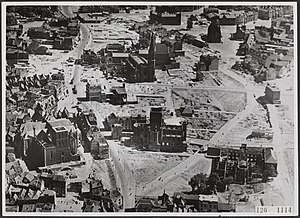This article's tone or style may not reflect the encyclopedic tone used on Wikipedia. (July 2023) |
| Bombing of Nijmegen | |||||||
|---|---|---|---|---|---|---|---|
| Part of World War II Operation Argument (Big Week) | |||||||
 Police photo from 1945: in the foreground, parts of the centre mainly bombed in February '44; most buildings in the background were not destroyed until Operation Market Garden (September 1944).[1] | |||||||
| |||||||
| Belligerents | |||||||
|
|
| ||||||
| Commanders and leaders | |||||||
|
(formation leader)[4][5] |
(commander Netherlands) | ||||||
| Strength | |||||||
| 14 B-24 Liberators[4] | Flaks | ||||||
| Casualties and losses | |||||||
| None | Railway station heavily damaged | ||||||
| c. 880 civilian deaths[6] | |||||||
The bombing of Nijmegen on 22 February 1944 was a target-of-opportunity aerial bombing raid by the United States Army Air Forces on the city of Nijmegen in the Netherlands, then occupied by Nazi Germany. In terms of the number of victims, it was one of the largest bombardments of a Dutch city during World War II. Officially, nearly 800 people (almost all civilians) were killed by accident due to inaccurate bombing, but because people in hiding were not counted, the actual death toll was likely higher. A large part of the historic city centre was destroyed, including Saint Steven's Church. Saint Augustine's Church and Nijmegen railway station (the intended target)[3] were heavily damaged as well.
The Dutch government-in-exile in London reestablished itself on the continent in early 1945 due to Canadian Army and other Allies' military efforts, and it avoided criticizing countries it relied upon for liberation and future security; thus national and local authorities largely remained silent on the bombing for decades, leaving survivors with unaddressed grief and questions, and allowing conspiracy theories to thrive. Although officials long maintained it had been an "erroneous bombardment", implying Nijmegen was the wrong target, historical research has shown that the attack was intentional, but executed poorly.
- ^ "Historische @tlas Nijmegen". Archived from the original on 29 June 2016. Retrieved 22 August 2016.
- ^ Cite error: The named reference
ATwas invoked but never defined (see the help page). - ^ a b c "Bombardement geen vergissing, wel een 'faux pas'". De Gelderlander. 21 February 2009. Archived from the original on 4 July 2015. Retrieved 20 August 2016.
- ^ a b Onno Havermans (28 March 2009). "Het bombardement was geen vergissing". Trouw. Archived from the original on 25 August 2016. Retrieved 24 August 2016.
- ^ Brinkhuis 1984, p. 29.
- ^ Brinkhuis 1984, p. 100.